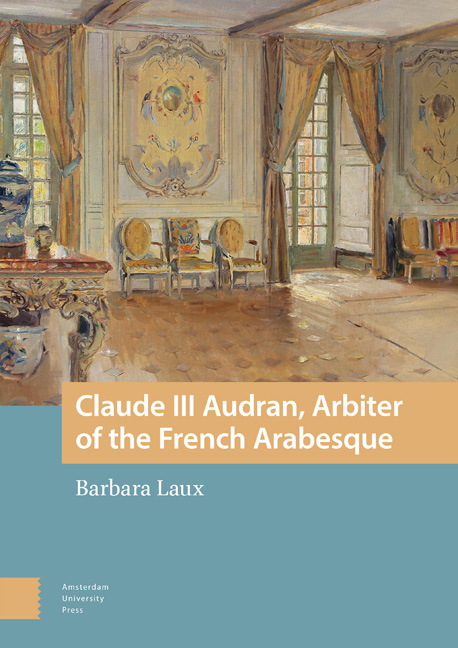Book contents
- Frontmatter
- Contents
- List of Illustrations
- Acknowledgements
- Introduction
- 1 Biography of Claude III Audran (1658–1734)
- 2 The French Arabesque as an Art Form, Audran as Master Ornamentalist , and His Initial Commissioned Works
- 3 Claude III Audran and Jean de La Fontaine’s Fables: Maintaining the Social Hierarchy
- 4 Attracting New Patrons in the Eighteenth Century
- 5 Claude III Audran’s Competitors and His Legacies
- Color Plates
- Appendix
- Bibliography
- Index
5 - Claude III Audran’s Competitors and His Legacies
Published online by Cambridge University Press: 08 May 2024
- Frontmatter
- Contents
- List of Illustrations
- Acknowledgements
- Introduction
- 1 Biography of Claude III Audran (1658–1734)
- 2 The French Arabesque as an Art Form, Audran as Master Ornamentalist , and His Initial Commissioned Works
- 3 Claude III Audran and Jean de La Fontaine’s Fables: Maintaining the Social Hierarchy
- 4 Attracting New Patrons in the Eighteenth Century
- 5 Claude III Audran’s Competitors and His Legacies
- Color Plates
- Appendix
- Bibliography
- Index
Summary
Abstract
Over the course of Audran's career, he employed a number of assistants who went on to have independent careers; many became members of the Académie royale de peinture et de sculpture. These artists, such as François Desportes, Jean- Antoine Watteau, Nicolas Lancret, and Christophe Huet, completed arabesques and developed the genre with their own interpretations as noted in their commissions.
Keywords: Alexandre-François Desportes; Nicolas Lancret; Jean-Baptiste Oudry; Christophe Huet; Claude Gillot
The case studies presented in the previous chapters explain Audran's work within the cultural milieu of his times and describe how he succeeded in his career. From the last decades of Louis XIV's reign through the Régence and to the beginning of the reign of Louis XV, the aesthetics of Audran's commissions responded in each period to the demands and desires of his patrons. Previous scholarship has confirmed Jean Berain's influence on draftsmen such as Pierre Lepautre (1659–1744), who is best remembered for his chimney designs. Additionally, Lepautre inaugurated the use of C-scrolls, curves, and counter-curves in three-dimensional carved panel design. Audran's arabesques often employed curves and counter-curves that became ubiquitous elements of Rococo style. His commissions at Meudon and the Ménagerie at Versailles, among others, set a new standard for noble patrons, creating a ripple effect of influence benefitting other craftsmen, artists, and architects.
This chapter begins by presenting a number of works by Audran's contemporaries to note Audran's influence in their work. Included is one example of a fellow member of the Maîtrise and others by various craftsmen and architects. In the course of Audran's career, he chose artists to assist him, and examples of their subsequent work will be discussed. These artists include Alexandre-François Desportes, Jean- Antoine Watteau, Nicolas Lancret, Jean-Baptiste Oudry, and Jean-Baptiste Huet.
The artist Pierre-Paul Sevin (1650–1710), a Parisian guild master, painted the parliamentary room in the Palais de Justice at Trévoux in 1698. This project provides a sense of the design approach used by the Maîtrise craftsmen, which appears markedly different from Audran's manner. Accompanying further examples of interior design commissions completed by Audran's contemporaries are explanations of the nature of their design projects and their use of alternative media.
- Type
- Chapter
- Information
- Claude III Audran, Arbiter of the French Arabesque , pp. 179 - 198Publisher: Amsterdam University PressPrint publication year: 2024



